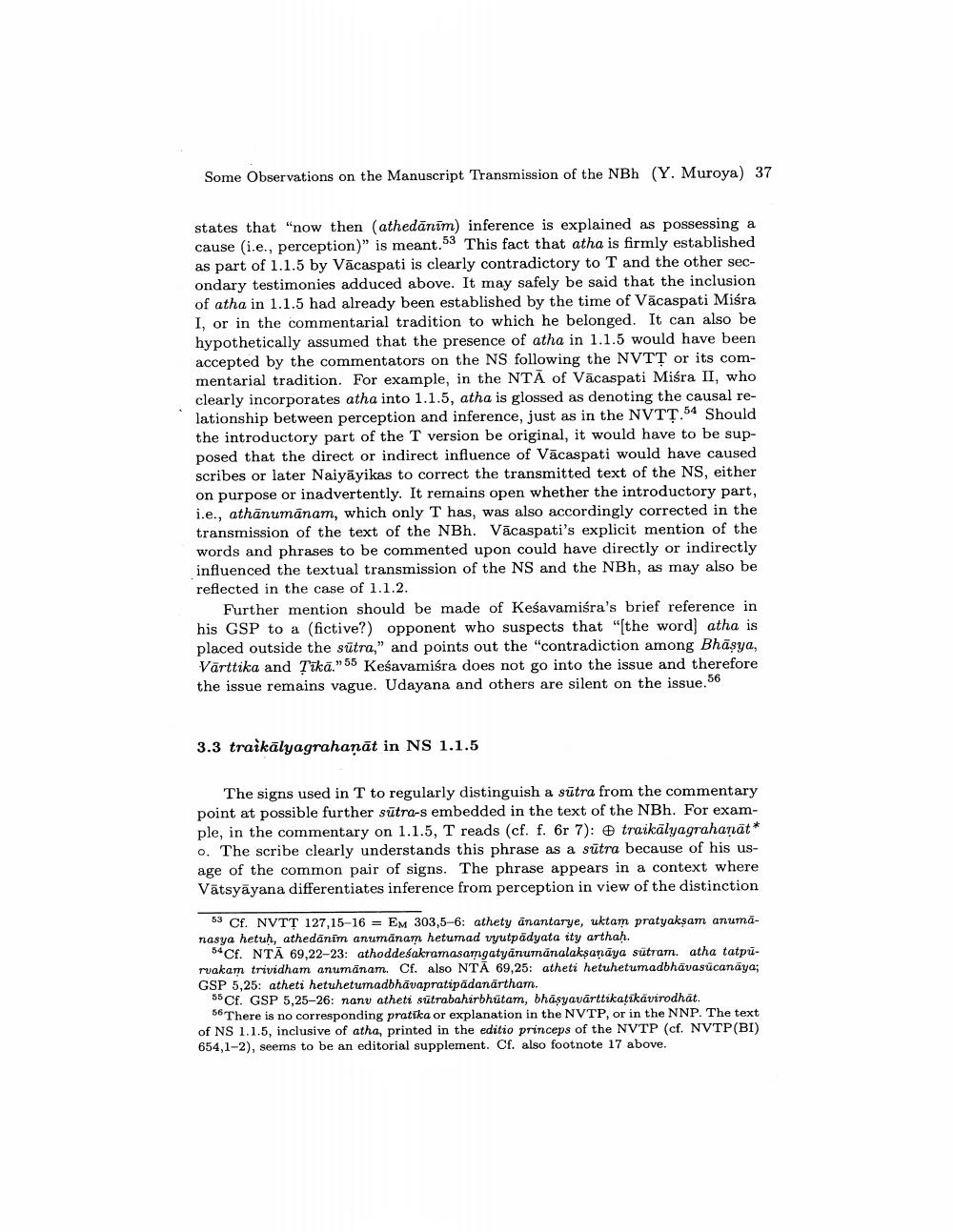________________
Some Observations on the Manuscript Transmission of the NBh (Y. Muroya) 37
states that "now then (athedānim) inference is explained as possessing a cause (i.e., perception)" is meant.53 This fact that atha is firmly established as part of 1.1.5 by Vācaspati is clearly contradictory to T and the other secondary testimonies adduced above. It may safely be said that the inclusion of atha in 1.1.5 had already been established by the time of Vācaspati Miśra I, or in the commentarial tradition to which he belonged. It can also be hypothetically assumed that the presence of atha in 1.1.5 would have been accepted by the commentators on the NS following the NVTT or its commentarial tradition. For example, in the NTĀ of Vācaspati Miśra II, who clearly incorporates atha into 1.1.5, atha is glossed as denoting the causal relationship between perception and inference, just as in the NVT?.54 Should the introductory part of the T version be original, it would have to be supposed that the direct or indirect influence of Vācaspati would have caused scribes or later Naiyāyikas to correct the transmitted text of the NS, either on purpose or inadvertently. It remains open whether the introductory part, i.e., athānumānam, which only T has, was also accordingly corrected in the transmission of the text of the NBh. Vācaspati's explicit mention of the words and phrases to be commented upon could have directly or indirectly influenced the textual transmission of the NS and the NBh, as may also be reflected in the case of 1.1.2.
Further mention should be made of Keśavamisra's brief reference in his GSP to a (fictive?) opponent who suspects that "[the word) atha is placed outside the sutra," and points out the "contradiction among Bhāsya, Vārttika and Tīkā."55 Keśavamiśra does not go into the issue and therefore the issue remains vague. Udayana and others are silent on the issue. 56
3.3 traikālyagrahaņāt in NS 1.1.5
The signs used in T to regularly distinguish a sütra from the commentary point at possible further sūtra-s embedded in the text of the NBh. For example, in the commentary on 1.1.5, T reads (cf. f. 6r 7): traikālyagrahanat* o. The scribe clearly understands this phrase as a sūtra because of his usage of the common pair of signs. The phrase appears in a context where Vātsyāyana differentiates inference from perception in view of the distinction
53 Cf. NVTT 127,15-16 = EM 303,5-6: athety anantarye, uktam pratyaksam anumānasya hetuh, athedānīm anumānam hetumad vyutpadyata ity arthah.
54 Cf. NTA 69,22-23: athoddesakramasamgatyanumanalaksaņāya sutram. atha tatpuruakam trividham anumānam. Cf. also NTĀ 69,25: atheti hetuhetumadbhāvasūcanāya; GSP 5,25: atheti hetuhetumadbhāvapratipädanärtham. 56 Cf. GSP 5,25-26: nanv atheti sutrabahirbhutam, bhasyavärttikatikavirodhat.
There is no corresponding pratika or explanation in the NVTP, or in the NNP. The text of NS 1.1.5, inclusive of atha, printed in the editio princeps of the NVTP (cf. NVTP(BI) 654,1-2), seems to be an editorial supplement. Cf. also footnote 17 above.




